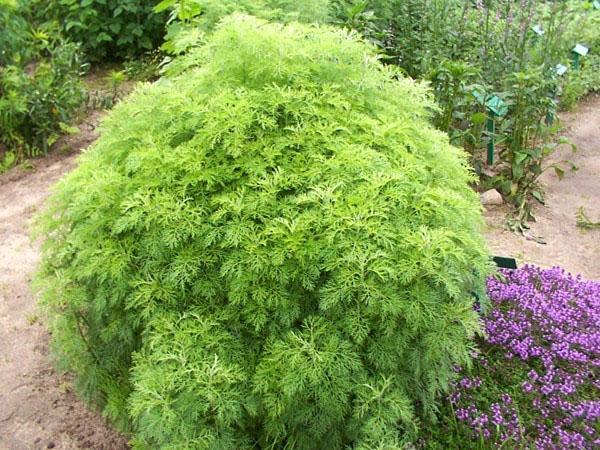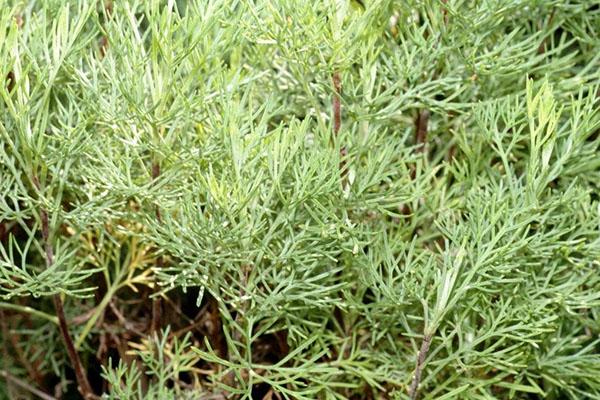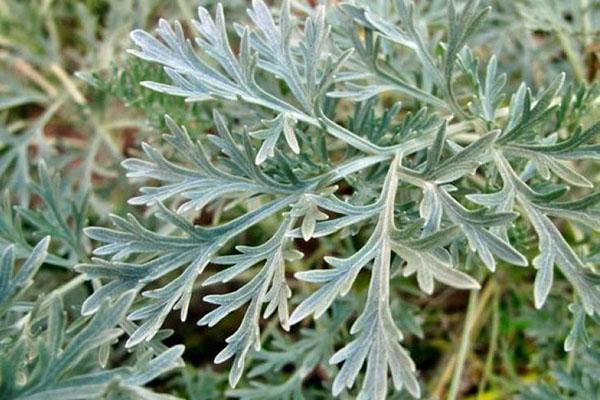Growing wormwood divine tree at their summer cottage is a pleasant experience for beginners
 The indescribable beauty of green spaces near country houses encourages more and more people to practice gardening. Growing wormwood is a great opportunity to take the first step towards your cherished goal. Although this culture is not very well-known, its distinctive beauty may well decorate a summer cottage. To appreciate the plant, let us turn our eyes to its charms.
The indescribable beauty of green spaces near country houses encourages more and more people to practice gardening. Growing wormwood is a great opportunity to take the first step towards your cherished goal. Although this culture is not very well-known, its distinctive beauty may well decorate a summer cottage. To appreciate the plant, let us turn our eyes to its charms.
Attractive features of a charming culture

In the natural environment, lemon wormwood is found:
- along the banks of rivers and lakes;
- in birch forests;
- near country roads.
 Therefore, when growing a wormwood tree at home, it is important to consider this fact. Despite a special love for moisture, the plant has erect, stiff shoots. They are strewn with many pinnately dissected leaves of a light gray or silver color. In the lower part of the plant, they grow together with the petioles.
Therefore, when growing a wormwood tree at home, it is important to consider this fact. Despite a special love for moisture, the plant has erect, stiff shoots. They are strewn with many pinnately dissected leaves of a light gray or silver color. In the lower part of the plant, they grow together with the petioles.
 When wormwood blooms, spherical buds appear that resemble miniature baskets. All of them are collected in loose panicles with a pleasant aroma. In the fall, boxes filled with seeds appear in their place. Unfortunately, they only mature in the southern regions of Europe. Therefore, the plant is mainly propagated vegetatively. An adult culture grows up to 1.2 m in height. The young greenery of the culture exudes a fresh aroma reminiscent of dill with an admixture of citrus and pine needles. Old shoots take on a bitter odor.
When wormwood blooms, spherical buds appear that resemble miniature baskets. All of them are collected in loose panicles with a pleasant aroma. In the fall, boxes filled with seeds appear in their place. Unfortunately, they only mature in the southern regions of Europe. Therefore, the plant is mainly propagated vegetatively. An adult culture grows up to 1.2 m in height. The young greenery of the culture exudes a fresh aroma reminiscent of dill with an admixture of citrus and pine needles. Old shoots take on a bitter odor.
Sometimes the divine tree is confused with the panicle wormwood, which propagates only by seeds. In addition, it is considered a two-year culture, while the medicinal wormwood is a perennial.
Growing wormwood God's tree: the main nuances
 Often, gardeners plant lemon wormwood on their plots as a medicinal crop. Therefore, she is not particularly looked after. The main thing is to provide her with regular watering and protect her from weeds... However, how to plant a wormwood tree to create a beautiful landscape on the territory of a country house? To do this, it is important to consider several principles that will help you achieve your cherished goal.
Often, gardeners plant lemon wormwood on their plots as a medicinal crop. Therefore, she is not particularly looked after. The main thing is to provide her with regular watering and protect her from weeds... However, how to plant a wormwood tree to create a beautiful landscape on the territory of a country house? To do this, it is important to consider several principles that will help you achieve your cherished goal.
Finding the perfect place

In order for a dill tree to successfully take root in a new site, the following points must be taken into account:
- an abundance of light;
- lack of drafts;
- suitable soil.
Southern culture will not be able to develop without a proper dose of sunlight. Therefore, a spacious and open area in a summer cottage is suitable for her. In addition, when growing wormwood, it is important to create artificial protection for it from strong winds. Thanks to this, the crop grows greener top faster and tolerates the winter cold more easily.
It is best to plant lemon wormwood along a hedge or building.
Suitable soil
 Practice shows that wormwood is a divine tree, does not tolerate high acidity of the soil. Therefore, they prepare loose soil with high-quality drainage for her. When the site is dug up, they add to the ground humus and chemical fertilizers. Then funnels are made at intervals of 1 m from each other, where the seedlings are placed. Immediately after planting, they are abundantly moisturized.
Practice shows that wormwood is a divine tree, does not tolerate high acidity of the soil. Therefore, they prepare loose soil with high-quality drainage for her. When the site is dug up, they add to the ground humus and chemical fertilizers. Then funnels are made at intervals of 1 m from each other, where the seedlings are placed. Immediately after planting, they are abundantly moisturized.
In order for the culture to successfully take root, it is necessary to monitor the soil surface. Drying out or waterlogging can lead the plant to death.
Propagation of a dill tree
 The best way to plant a divine tree in a summer cottage is by cuttings or by dividing a bush. Fully ripe specimens are suitable for planting, which are cut at the end of April. The cuttings are placed in a container of water for 10 days to form young roots. Then the seedlings are planted in a garden bed and watered regularly for 15 days.
The best way to plant a divine tree in a summer cottage is by cuttings or by dividing a bush. Fully ripe specimens are suitable for planting, which are cut at the end of April. The cuttings are placed in a container of water for 10 days to form young roots. Then the seedlings are planted in a garden bed and watered regularly for 15 days.
For breeding wormwood, cuttings at least 15 cm long are suitable.
Those who wish to grow seedlings use purchased seeds. They are sown in small containers and laid out on windowsills where there is a lot of sunlight. When the seedlings grow up to 20 cm, they are planted in a garden bed.
Important points of care
 Some gardeners say that wormwood grows well even without proper care. However, to create a beautiful plant, you still have to make an effort. The secrets of planting and caring for wormwood trees include a number of activities that contribute to the successful development of the plant.
Some gardeners say that wormwood grows well even without proper care. However, to create a beautiful plant, you still have to make an effort. The secrets of planting and caring for wormwood trees include a number of activities that contribute to the successful development of the plant.
Humidification frequency
Since the god tree is quite resistant to dry periods, it does not need abundant watering. On hot days, it is moistened once every 14 days, pouring at least 4 liters of water under each bush.
Pest control
Often, aphids settle on the leaf plates of a plant, which adversely affects its decorative effect. Treatment of wormwood with soapy water will help to get rid of it: 200 g of laundry soap is taken for 10 liters of liquid. The bushes are sprayed 3 times every 7 days.
Formation of an ornamental bush
Growing wormwood is not possible without regular pruning. It is best to prune the divine tree in early spring when severe frosts are behind. Young shoots are shortened to a height of about 5 cm. In order for the wormwood bush to grow on the sides, gardeners pinch its upper shoots. For regular rejuvenation, all old branches are removed from the bushes.
Creating a stylish country house territory
 Artemisia is not only a beneficial crop for health.
Artemisia is not only a beneficial crop for health.  It is widely used as a decorative decoration for the backyard area.
It is widely used as a decorative decoration for the backyard area.
The plant is planted in flower beds with flowering crops:
- lilac;
- jasmine;
- hydrangea;
- forsythia;
- rhododendron;
- roses;
- spirea.
The wormwood tree in landscape design looks wonderful along garden alleys or as a hedge.  Its silvery shoots are harmoniously combined with flowers that bloom at different times. Creative gardeners form cypress-shaped trees from wormwood. This approach helps to create an exotic oasis for relaxation on the site. Often, the plant is planted in spacious containers, which are placed on balconies or open verandas. In the summertime, the tart scent of the tree of god scares annoying insects away. Truly an amazing plant for greenery lovers.
Its silvery shoots are harmoniously combined with flowers that bloom at different times. Creative gardeners form cypress-shaped trees from wormwood. This approach helps to create an exotic oasis for relaxation on the site. Often, the plant is planted in spacious containers, which are placed on balconies or open verandas. In the summertime, the tart scent of the tree of god scares annoying insects away. Truly an amazing plant for greenery lovers.